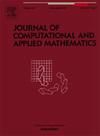A fuzzy multiple regression model adopted with locally weighted and interval-valued techniques
IF 2.6
2区 数学
Q1 MATHEMATICS, APPLIED
Journal of Computational and Applied Mathematics
Pub Date : 2025-05-21
DOI:10.1016/j.cam.2025.116751
引用次数: 0
Abstract
In this study, a new method for fuzzy linear regression analysis characterized by crisp predictors and fuzzy responses is proposed. The fuzzy responses are decomposed into two separate closed intervals, and then a fuzzy linear regression model is fitted by using the mid-points and ranges of the interval values that result from the center and bounds of the fuzzy responses. The coefficients of the model are estimated within a three-steps procedure by means of the locally weighted estimation procedure. In each step, the unknown bandwidth for identifying the neighboring data points is specified by means of cross-validation. The fuzzy predicted values are then determined via the mid-points and ranges of the predicted interval values. As for performance assessment and comparison with other fuzzy regression models, two approved goodness-of-fit measures are computed. The practical applicability of the proposed model is investigated in the context of a simulation study and four real-data applications. The empirical results reveal the superiority of the introduced regression model compared to its competitors.
采用局部加权和区间值技术的模糊多元回归模型
本文提出了一种预测因子清晰、响应模糊的模糊线性回归分析方法。将模糊响应分解为两个独立的封闭区间,然后利用模糊响应的中心和边界得到的区间值的中点和范围拟合模糊线性回归模型。采用局部加权估计方法,分三步对模型的系数进行估计。在每一步中,通过交叉验证的方式指定用于识别相邻数据点的未知带宽。然后通过预测区间值的中点和范围确定模糊预测值。在性能评价和与其他模糊回归模型的比较中,计算了两个被认可的拟合优度。通过一个仿真研究和四个实际数据应用,验证了该模型的实用性。实证结果表明,所引入的回归模型相对于其竞争对手具有优势。
本文章由计算机程序翻译,如有差异,请以英文原文为准。
求助全文
约1分钟内获得全文
求助全文
来源期刊
CiteScore
5.40
自引率
4.20%
发文量
437
审稿时长
3.0 months
期刊介绍:
The Journal of Computational and Applied Mathematics publishes original papers of high scientific value in all areas of computational and applied mathematics. The main interest of the Journal is in papers that describe and analyze new computational techniques for solving scientific or engineering problems. Also the improved analysis, including the effectiveness and applicability, of existing methods and algorithms is of importance. The computational efficiency (e.g. the convergence, stability, accuracy, ...) should be proved and illustrated by nontrivial numerical examples. Papers describing only variants of existing methods, without adding significant new computational properties are not of interest.
The audience consists of: applied mathematicians, numerical analysts, computational scientists and engineers.

 求助内容:
求助内容: 应助结果提醒方式:
应助结果提醒方式:


